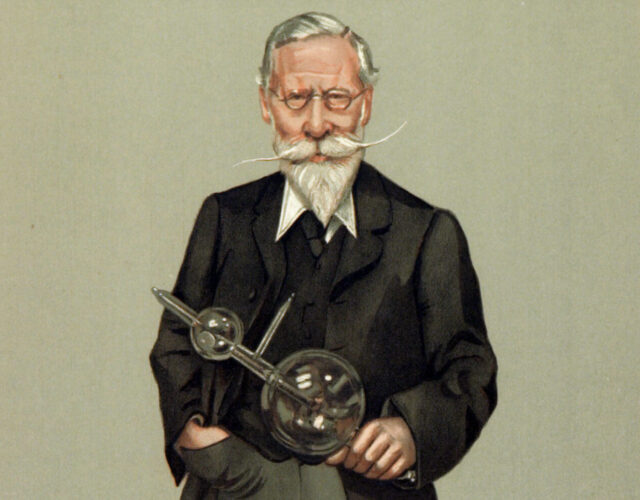In 1862 a controversy erupted in the chemical world. The International Exhibition in London had just awarded a medal to Frenchman Claude-Auguste Lamy for his successes with thallium. But William Crookes (1832– 1919)—a 30-year-old semi-professional English chemist and journalist—claimed that his work, then unrecognized, deserved credit.
Crookes studied under August Wilhelm von Hofmann at the Royal College of Chemistry and after a brief career in academia settled into life as the editor of Chemical News and Photographic News. He continued with chemical experimentation, however, and his images of solar spectra, developed using his photographic and chemical knowledge, earned him recognition in the London scientific arena.
Meanwhile, on the Continent, chemists struggled to find new elements, especially the difficult-to-isolate rare-earth elements. Robert Bunsen and Gustav Kirchhoff, two chemists working at Heidelberg University, succeeded. The two men knew that each element glows with a frequency specific to itself when heated. They passed the light emitted by these glowing samples through a prism, which produced a unique spectrum, and used the spectral lines to identify elements old and new. Through this process Bunsen and Kirchhoff discovered cesium in 1860. They named the element after the word caesius—Latin for “sky-blue”—after the deep-blue spectral line that identified it.
Scientists who unearthed new elements earned huge amounts of prestige, so when Crookes heard of Bunsen and Kirchhoff’s discovery, he set out on a quest for a new element. He failed several times, but also inadvertently stumbled upon an omission by Bunsen and Kirchhoff in their map of the calcium spectrum. This led a pair of French spectroscopists to falsely claim the finding of a new element in their samples of calcium. Bunsen and Kirchhoff, meanwhile, had been producing cesium by distilling mineral water from Germany’s famous spa towns of Kreuznach and Baden-Baden. When one of Bunsen’s students announced the discovery of rubidium, found in the residue of this distillation, Crookes immediately switched his attention to similar residues. In May 1861 Crookes noticed a bright-green line never seen before in the spectrum of a sample of selenium left over from experiments during his college days. He named the new element thallium, from the Greek thallos, the color of young shoots. Thallium would soon come to fame as the “poisoner’s poison” for its use as a murder weapon.
Crookes presented a sample of his element at the 1862 International Exhibition, where he was introduced to Lamy. The Frenchman embarrassed Crookes by pronouncing that the small amount of powder Crookes had brought was thallium sulfide and not pure metal like the ingot Lamy had presented. The feud that erupted between the two men rested on the definition of discovery. Because spectral analysis was so new and required so little of the element, it raised the question of who should receive credit: the one who discovers the spectrum or the one who isolates the element? Crookes was recognized after the exhibition by the awards committee, but not before using his editorial position at Chemical News to turn the publication into an anti-Lamy outlet. As the first Englishman since Humphry Davy to discover an element, Crookes’ precarious status as thallium’s discoverer quickly turned into a contest pitting English science against French.
The feud was never resolved. With his election to the Royal Society in 1863, Crookes finally gained the prestige and legitimacy he sought and abruptly stopped publishing on the thallium controversy. Lamy would do well for himself, moving in 1866 to the reputable École Central des Arts et Manufactures in Paris. But to this day Crookes gets most of the credit for discovering the highly toxic element, which may result more from his later illustrious career as a physicist and tenure as president of the Royal Society than any consensus on the primacy of spectral analysis.




